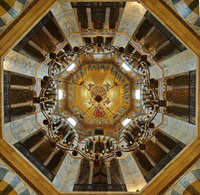Speaker
Description
NPDGamma is an experimental collaboration which for over 20 years has made an effort in research and development to measure the parity-violating gamma-ray asymmetry in the capture of polarized low-energy neutrons on hydrogen. This asymmetry is dominated by a $\Delta I=1$ ${}^{3}S_{1}-{}^{3}P_{1}$ parity-odd transition in the $n-p$ system. In the more traditional theoretical framework, the one-meson-exchange model, developed in the 80’s by Desplanques, Donoghue and Holstein (among others), this asymmetry is related to the weak pion-exchange coupling constant $h_{\pi}^{1}$, which characterizes the longest-range contribution in the Hadronic Weak Interaction (HWI). This system has the advantage of not being obscured by the lack of knowledge, to a sufficient precision, of nuclear wave functions; $ab$ $initio$ calculations are possible for the $n-p$ system. Additional scientific interest in this system comes from the fact that charged currents are suppressed in the $\Delta I=1$ channel, so it constitutes one of the few systems available to study neutral currents at low energies. More modern theoretical approaches have implemented Effective Field Theories (EFT) in the study of the HWI. At low-energies, in the pion-less EFT, the weak interaction is characterized by five low-energy constants (LECs) related to the possible $S-P$ transitions, and in the expansion to infinite number of colors, $N_{c}$, applied to the HWI by Schindler, Springer and Vanasse, a hierarchization of the LECs has been achieved. Particularly, the LEC related to the $^{3}S_{1}-^{3}P_{1}$ transition is expected to be suppressed. Testing the large-$N_{c}$ expectations is an important step towards a better understanding of the HWI. In this talk I will describe the different stages of the experiment and will present the final result achieved by the NPDGamma collaboration.
